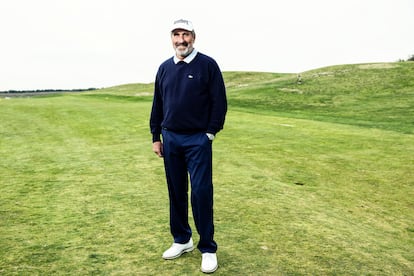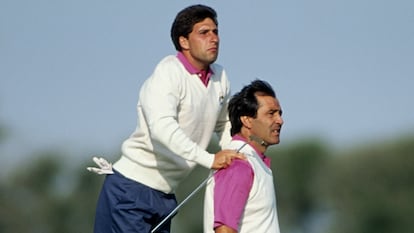José María Olazabal: “Jon Rahm could make history, but I don’t know if he will be able to do it now”

Golf is still a strong thing in the heart of José María Olazabal. The golfer from Hondarribia (Gipuzkoa) has just turned 59 and still has an intact love for his sport, as if he were still the child who learned to play next to the family home on the Jaizkibel course, where his grandfather and father looked after the land. He even tears up when he remembers Seve Ballesteros. The two-time Masters champion (1994 and 1999) has just been appointed by the new president of the federation, Juan Guerrero-Burgos, as sports advisor to the national teams and the Pro Spain programme, which accompanies young people on their leap into the professional world. Visiting Madrid to mentor this generation, Olazabal reflects on the past and the present.
Question: Do you like the role of teacher?
Answer: Yes, I like teaching. Golf has given me everything in life. I come from a generation in which we had to help each other. And that culture prevails. At that time we didn't have technology, or videos. I trained with José María Cañizares, Pepín Rivero, Manolo Piñero... We shared a room and I turned to them when I was lost. Now I try to maintain that culture with young people. I won't have great achievements in this sport anymore, but I can transmit what I have learned to these generations, who will have a hard time because the level is very high.
Q. What do you want to convey?
A. I'm not talking about technique. Everyone has their own coach. I want to convey to them the respect for the game. Golf is a way of life. When you're playing there's a struggle between the devil inside you and the positive person you want to be. We've all been there, even the best player in the world has had destructive thoughts. The kids need to be aware that you're not the only one who goes through that and that you have to live with it, talk to that devil and say: "We're going to make this journey together."
Q. Is it difficult to teach respect?
A. I don't think so. The good thing about golf is that you are your own judge and if you cheat, you are cheating yourself. If you go out to practice alone, what good does it do to miss a shot and say you have made par? Golf teaches you that there are no shortcuts. You either work hard or nothing. It is a great teacher of life. In general, the kids who reach this level have good values because this sport has instilled them in them. Humility is something intrinsic to golf. You can't think that you are bigger, because it will put you in your place. We have all gone through a crisis where you question whether you will play well again.
Q. Do you see much difference between the young man you were and the young man today?
A. Without a doubt. We were more innocent, we didn't have the knowledge that young people have today. You had to play with Nick Faldo or Seve and you arrived feeling inhibited, scared. This generation is not afraid. They are better prepared thanks to all the information they have. And they have a huge confidence in themselves because they rely on numbers and data. Doubt disappears. Necessity made us players. But if I had to choose, I'd stick with the era I lived in. It was an adventure, you didn't know what was out there, there were no facilities. In the first years on the European circuit I had to travel with my bag of balls, find a place among the caddies , there were no official hotels or courtesy cars. We made a living. That's prehistory. Today everything is more professional, there is no room for gaps. And something saddens me: we have lost the coexistence, the personal relationships. Before, after playing we would go to the hotel, play cards and tell each other about our lives. Today they have no time for anything, it is full dedication.

Q. Is there a rush to want it all now?
R. They want everything done yesterday. That doesn't work in golf. It's a marathon more than a 100-metre race, you have to have enormous perseverance. You can put in many hours and not see results. You need a strong character to not break down.
Q. How do you see golf today?
A. It's a shame how divided it is. It's very difficult to solve. We all notice it. Before there was a status quo that wasn't perfect, but that met the needs of the public. Today that doesn't happen because of the division between LIV and the other circuits. It makes me sad. Golf is a wonderful, attractive sport, and now not being able to see the best together makes you lose a bit of interest.
Q. Do you like LIV as a product?
A. No. Call me traditional, but I don't like the format. I don't like the fact that they all come out at the same time, in three days, without a break, with all that paraphernalia around them, the music... It makes me sad that money has divided golf. It's because of money, there's no doubt about it. I've always respected the decision of those who have left. If you had put a cheque in front of me with a bunch of zeros on it, I might have done it too. But it's a shame that money has destroyed in such a short time what had been built up over so many years.
Q. Were you surprised by Jon Rahm’s decision to go to LIV?
A. Yes, I have to be honest. I was a little surprised. I insist, I respect that you are leaving with those conditions, with the huge amount of millions that they are putting on the table for you. I respect that, but I was surprised because Jon had been very clear in his words and because he had an extraordinary future and the opportunity to make history in this sport, to write golden pages of golf. And I don't know if he will be able to do it now. I don't know if playing the LIV is the best preparation to be able to stand out in the big ones. From my point of view it is not the best option. Above all it can harm him in terms of competitiveness. I don't question Jon's self-esteem, work and attitude at any time. When he gets to the Masters this year he will give it his all and he will prepare himself in the best way, but the rest of the season, playing 12 or 14 tournaments without a cut, with 54 players... it is not the same as playing against 150 and knowing that you can go home. I am terribly sorry that Jon is not among the top 50 in the world [he is 54th]. He is a great player and should be with Scheffler fighting every week to win everything.

Q. What would Seve think of LIV?
R. He was a defender of being able to play wherever you wanted, but history was also very important to him, leaving a mark, marking an era. And I think LIV is not going to give you that.
Q. How much do you remember about Seve?
A. A lot. The week of the Masters, as soon as I walk through the door. When I watch the British Open on television. I miss him. He opened many doors for us, he did great things for European golf on a global level, he had extraordinary charisma and was an example on the course: attitude, fighting spirit, never giving up...
Q. What is it about the Masters that has been a channel for broadcasting Spanish golf, from Seve to you, Sergio García, Jon Rahm?
R. Augusta needs a certain player. The key is distance control with the irons and the short game. All of those players have had a very, very good short game.
Q. What do you think about Tiger still fighting to be at the top?
R. This sport is addictive in a way that is difficult to explain. None of us have retired because it is in our blood. If Tiger wants, he can be an inspiration for many young people. He and I have a lot of respect for each other.
EL PAÍS






